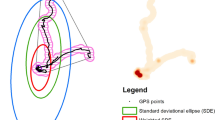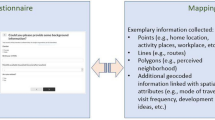Abstract
With the increasing use of the Internet for getting information, transacting business and interacting with people, a wide range of activities in everyday life can now be undertaken in cyberspace. As traditional models of accessibility are based on physical notions of distance and proximity, they are inadequate for conceptualizing or analyzing individual accessibility in the physical world and cyberspace (hereafter referred to as hybrid-accessibility). To address the need for new models of space and time that enable us to represent individual accessibility in the information age, there are at least three major research areas: (a) the conceptual and/or behavioral foundation of individual accessibility; (b) appropriate methods for representing accessibility; and (c) feasible operational measures for evaluating individual accessibility. With the recent development and application of GIS methods in the study of accessibility in the physical world (e.g., Forer 1998, Hanson, Kominiak, and Carlin 1997, Huisman and Forer 1998, Kwan 1998, 1999a, 1999b, Miller 1991, 1999, Scott 1999, Talen 1997, Talen and Anselin 1998), it is apparent that GIS have considerable potential in each of these research areas. As shown in some of these studies, a focus on the individual enabled by GIS methods also reveals the spatial-temporal complexity in individual activity patterns and accessibility through 3D visualization or computational procedures.
Access this chapter
Tax calculation will be finalised at checkout
Purchases are for personal use only
Preview
Unable to display preview. Download preview PDF.
Similar content being viewed by others
References
Adams, P.C. 1995. A reconsideration of personal boundaries in space-time. Annals of the Association of American Geographers 85(2):267–85.
Adams, P.C. 1998. Network topologies and virtual place. Annals of the Association of American Geographers, 88(1):88–106.
Burns, L. 1979. Transportation, Temporal, and Spatial Components of Accessibility. Lexington, MA: Lexington Books.
Carlstein, T. 1982. Time Resources, Society and Ecology: On the Capacity for Human Interaction in Space and Time in Preindustrial Society. Lund Studies in Geography, Series B, Human Geography No.49. Lund, Sweden: CWK Gleerup.
Couclelis, H. 1994. Spatial technologies. Environment and Planning B 21:142–43.
Forer, P. 1998. Geometric approaches to the nexus of time, space, and microprocess: implementing a practical model for mundane socio-spatial systems. In Egenhofer, M.J. and Golledge, R.G. (eds.) Spatial and Temporal Reasoning in Geographic Information Systems. Oxford: Oxford University Press, 171–90.
Giddens, A. 1984. The Constitution of Socity: Outline of the Theory of Structuration. Berkeley, CA: University of California Press.
Hägerstrand, T. 1970. What about people in regional science? Papers of the Regional Science Association, 24:7–21.
Hanson, S., Kominiak, T. and Carlin, S. 1997. Assessing the impact of location on women’s labor market outcomes: A methodological exploration. Geographical Analysis 29:281–97.
Hodge, D. 1997. Accessibility-related issues. Journal of Transport Geography 5(l):33–4.
Huisman, O. and Forer, P. 1998. Towards a geometric framework for modelling space-time opportunities and interaction potential. Paper presented at the International Geographical Union, Commission on Modelling Geographical Systems Meeting (IGU-CMGS), 28–29 August, Lisbon, Portugal.
Janelle, D. 1973. Measuring human extensibility in a shrinking world. Journal of Geography 72(5):8-l5.
Janelle, D. 1995. Metropolitan expansion, telecommuting, and transportation. In Hanson, S. (ed.) The Geography of Urban Transportation, 2 nd edition. New York: Guilford, 407–34.
Kwan, M-P. 1998. Space-time and integral measures of individual accessibility: A comparative analysis using a point-based framework. Geographical Analysis, 30(3): 191–216.
Kwan, M-P. 1999a. Gender and individual access to urban opportunities: A study using space-time measures. The Professional Geographer 51 (2):210–27.
Kwan, M-P. 1999b. Gender, the home-work link, and space-time patterns of non-employment activities. Economic Geography 75(4).
Kwan, M.P. 2000. Cyberspatial cognition and individual access to information: The behavioral foundation of cyber-geography. Environment and Planning B, in press.
Kwan, M-P. and Hong, X-D. 1998. Network-based constraints-oriented choice set formation using GIS. Geographical Systems, 5:139–62.
Lenntorp, B. 1976. Paths in Time-Space Environments: A Time Geographic Study of Movement Possibilities of Individuals. Lund Studies in Geography, Series B, Human Geography No.44. Lund, Sweden: CWK Gleerup.
Math Soft. 1997 S-Plus User’s Guide. Seattle, WA: MathSoft, Inc.
MCI, 1998. Internet Traffic Report <http://www.traffic.mci.com/>
MIDS, 1998. The MIDS Internet Weather Report (IWR) <http://www.mids.org/weather/us/htmldir/>
Miller, H.J. 1991. Modelling accessibility using space-time prism concepts within geographic information systems. International Journal of Geographical Information Systems 5(3):287–301.
Miller H.J. 1999. Measuring space-time accessibility benefits within transportation networks: Basic theory and computational procedures. Geographical Analysis 31(2): 187–212.
Pred, A. and Palm, R. 1978. The status of American women: A time-geographic view. In Lanegran, D.A. and Palm R. (eds.). An Invitation to Geography. New York: McGraw-Hill, 99–109.
Rose, G. 1993. Feminism and Geography: The Limits of Geographical Knowledge. Minneapolis, MN: University of Minnesota Press.
Scott, L.M. 1999. Abstract — Evaluating intra-metropolitan accessibility in the information age: Operational issues, objectives, and implementation. In Janelle, D.G. and Hodge, D.C. (eds.) Measuring and Representing Accessibility in the Information Age, Research Conference Report. Santa Barbara CA: NCGIA, 30–31.
Talen, E. 1997. The social equity of urban service distribution: An exploration of park access in Pueblo, Colorado, and Macon, Georgia. Urban Geography, 18(6):521–41.
Talen, E. and Anselin L. 1998. Assessing spatial equity: An evaluation of measures of accessibility to public playgrounds. Environment and Planning A, 30:595–613.
Thrift, N. 1985. Flies and germs: a geography of knowledge. In Gregory, D. and Urry, J. (eds) Social Relations and Spatial Structures. New York: St. Martin’s Press, 366–403.
Villoma, O.G. 1989. An Operational Measure of Individual Accessibility for Use in the Study of Travel-Activity Patterns. Ph.D. dissertation, Graduate School of the Ohio State University.
Author information
Authors and Affiliations
Editor information
Editors and Affiliations
Rights and permissions
Copyright information
© 2000 Springer-Verlag Berlin Heidelberg
About this chapter
Cite this chapter
Kwan, MP. (2000). Human Extensibility and Individual Hybrid-accessibility in Space-time: A Multi-scale Representation Using GIS. In: Janelle, D.G., Hodge, D.C. (eds) Information, Place, and Cyberspace. Advances in Spatial Science. Springer, Berlin, Heidelberg. https://doi.org/10.1007/978-3-662-04027-0_14
Download citation
DOI: https://doi.org/10.1007/978-3-662-04027-0_14
Publisher Name: Springer, Berlin, Heidelberg
Print ISBN: 978-3-642-08692-2
Online ISBN: 978-3-662-04027-0
eBook Packages: Springer Book Archive




